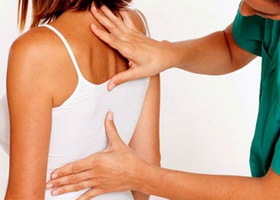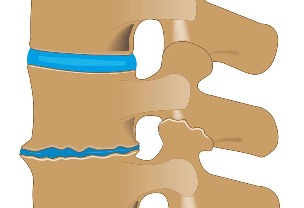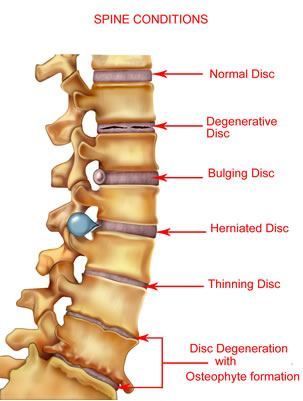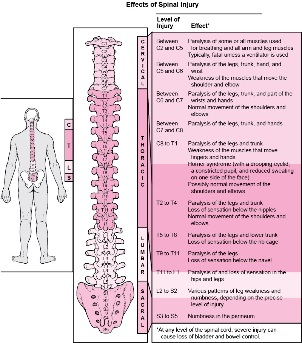
General information
A disease of the human musculoskeletal system such as osteochondrosis is essentially a degeneration of articular cartilage and nearby bone tissue, with the frequent involvement of adjacent vessels, muscles, and nerve endings in the pathological process. In principle, this term can mean a series of osteoarticular pathologies of various locations, even with the joints of the extremities, but more frequently it is used to denote degenerative-dystrophic changes in the structure. directly to the spine and especially to the intervertebral discs.
As a result of the progression of intervertebral osteochondrosis, the human body loses its inherent shock absorbing qualities, mobility and elasticity. In general, this disease of the spine is widespread and in one or more people have a different degree of severity by the age of 40 years. Depending on the segment of the spine affected in clinical practice, there are cervical, lumbar and thoracic osteochondrosis, as well as their mixed forms, which are considered the most difficult.
Osteochondrosis of the thoracic spine, which will be discussed in this article, is the rarest form of this pathology, which, in particular, is due to the anatomical structure of the upper part of the human skeleton. So, in the chest area, the osteochondral system consists of 12 vertebrae, which are connected by means of joints with ribs, which with their front ends join a relatively monolithic sternum. Such a skeletal structure provides enougha rigid and strong framework that protects the organs of the thoracic cavity (heart, lungs) from injury. In addition, the vertebrae of this segment of the spinal column are characterized by a small height and a significant length of the spinous processes, which gives them a highly spaced tile appearance. All this together limits the mobility of this part of the back and the negative effect of physical activity on it, protecting the intervertebral discs from destruction.

As another reason for the lower frequency of detection of chest osteochondrosis in a person, compared to lumbar and cervical osteochondrosis, physiological kyphosis (natural backward curvature of the spine) appears in this area, due to the greaterpart of the external load falls on the anterior and lateral fragments of the vertebrae and discs. With the development of a pathological process in the spinal movement segment, it is these areas that are primarily exposed to degenerative diseases. changes, however, due to the absence of nerve endings and membranes of the spinal cord in them, pain is most often not observed. However, in some cases, negative transformations in the thoracic segment of the spinal column affect posterior disc and vertebra fragments and / or vertebral-costal joints, which often leads to compression of the spinal nerve roots. In such conditions, osteochondrosis of the thoracic spine occurs with radicular syndrome, which is already accompanied by pain of diverse localization (sometimes very distant), as well as a violation of the functionality of many organs of the human body (liver, lungs, pancreas. , heart, etc. ).
Due to the highly ambiguous and varied manifestations of thoracic osteochondrosis, doctors often call this form of pathology "chameleon disease" as it can be cleverly disguised as symptoms of respiratory and digestive diseases. heart muscle, etc. In this situation, a correctly carried out differential diagnosis is very important, which, through various specific studies, will help to determine the symptoms and treatment of osteochondrosis of the thoracic spine.
The tactics and effectiveness of additional therapy will largely depend on the degree of progression of the degenerative-dystrophic process in the tissues of the spine. Having recognized the pathology in the initial stages of its development, it is important to improve the patient's condition. it is quite possible with the help of simple physiotherapeutic techniques and exercise therapy exercises, but in the case of its late detection, a complex surgical operation may be necessary. That is why vertebrologist doctors strongly recommend when any frequent and / or prolonged back pain seek the help of a specialist as soon as possible.
Pathogenesis
The incidence of osteochondrosis of the thoracic spine in women and men is practically identical, since the pathogenesis of this disease does not have a gender predisposition to the appearance of degeneration of the intervertebral disc. However, many years of clinical experience in the treatment of osteochondrosis indicates that its first symptoms in men appear at a younger age than similar negative symptoms in women. In particular, this is due to the fact that osteochondral tissues of the female body up to a certain age are protected by the hormone estrogen, the decrease in the level of which at the time of climacteric transformations serves as a trigger for problems in the spine.
According to statistical evidence, in general, intervertebral osteochondrosis in varying degrees of severity is found in most of the elderly, which automatically classifies it in the group of age-related diseases. Meanwhile, the last time is followed by a significant "rejuvenation" of this pathology, until its appearance in preschool age. For this reason, it has not been possible to establish the exact etiology and initial pathogenesis of spinal osteochondrosis to this day. At one time, more than a dozen theories about its origin and development were developed, including hormonal, infectious, mechanical, vascular, hereditary, allergic and others, but in practice none of them have found complete confirmation.
Today, doctors explain the appearance of osteochondrosis by the sum of complementary negative effects on the tissues of the spine, among which a constant excessive load on one or more movements of the spine. segments formed by two adjacent vertebrae (superior and inferior) and a disc located in the middle of them. Paradoxically, such an overload can be a consequence both of excessive physical work on the spine and of the long-term results of its finding in an unnatural position for the back. For example, prolonged work or study in a sitting position at the table is one of the main factors in the development of degenerative-dystrophic changes in the intervertebral structure. disk.
The initial formation or exacerbation of osteochondrosis of the thoracic spine can be influenced by poor nutrition, uneven development of the thoracic and thoracic muscles, excessive weight (obesity), pathology of the lower extremities (eg flat feet), back injuries, etc. Disruption of segmental blood circulation plays an important role in the pathogenesis of this disease, which causes dehydration of the nucleus pulposus (gelatinous), which in turn leads to loss of the amortization qualities of the intervertebral disc, change of loads in thesurrounding annulus fibrosus and further gradual destruction of this spinal motion segment.
In the process of its progression, thoracic osteochondrosis goes through 4 consecutive stages of development, each of which is characterized by its own anatomical and morphological changes in the structure of the disc, adjacent vertebrae and facet. joints. Furthermore, the negative metamorphoses that take place with this disease can directly affect other nearby tissues (muscle, vascular, connective) or indirectly affect the work of remote organs and systems of the human body. (intestines, heart, lungs, etc. ).

First grade
At the initial stage of the formation of thoracic osteochondrosis, microcracks form in the inner membrane of the fibrous annulus, into which the nucleus pulposus begins to gradually penetrate, irritating the nerve endings in the distal layers of the fibrous annulus. rings and in the posterior longitudinal ligament. At this stage in the development of the disease, the patient may already feel pain in the middle of the back or apparent pain in the heart area. You may also be haunted by a convulsive twitching sensation. in the dorsal muscles.
Second grade
Osteochondrosis of the thoracic spine of the second degree is characterized by increased destruction of the fibrous ring, which is accompanied by instability of the spine, as a result of excessive mobility of its affected vertebrae. PainfulThe sensations of the second stage of the development of the pathology intensify and may proceed as back pain (persistent mild pain, aggravated by back movements) or dorsagus (arising sharply against the background of a prolonged stay in one position, strongPains "stabbing ").
Third degree
In the third period of thoracic osteochondrosis, there is a complete rupture of the structure of the annulus fibrosus with the exit of the nucleus pulposus beyond its edges and the formation of an intervertebral hernia. Most often, such formations arise in the direction of the vertebra. canal, leading to compression of the spinal cord, spinal nerves, and adjacent vessels. This is accompanied by radicular syndrome (pain radiating to different parts of the body), thoracalgia in the context of osteochondrosis (severe pain behind the sternum, resembling acardiac), myelopathy (sensory and motor disorders) and other symptoms of a neurovascular and muscle tonic nature. . Fixed thoracic kyphosis, scoliosis, or kyphoscoliosis can begin at this stage.
Fourth degree
During the final stage of thoracic osteochondrosis, degenerative processes spread to the interspinous and yellow ligaments, other tissues of the spine, and nearby muscles. Intervertebral disc dystrophy continues to progress to scarring and additional fibrosis. Deforming arthrosis develops in the semilunar and intervertebral joints, osteophytes (bone growths) are formed in the processes of the vertebrae. The clinical picture in this period of the disease can be quite versatile, since the degree of damage to individual discs is usually different. In uncomplicated osteochondrosis, fibrosis of the problematic disc can mark the transition of the disease to the stage of stable remission, but with a loss of normal functionality to one degree or another. spinal column.
Reasons
Thoracic osteochondrosis in men and women can develop due to the following predisposing factors:
- the natural physiological aging process, accompanied by age-related changes in the structure of the bone-cartilage tissue of the spine;
- genetic predisposition to abnormal formation of spinal movement segments;
- a physically inactive lifestyle leading to dystrophy of the back muscles;
- strength sports involving excessive mechanical stress on the spine (mainly weight lifting);
- spinal injuries (including those that occurred in the distant past);
- endocrine disorders in the human body, altering the nutrition of the tissues of the spine;
- significantly above normal body weight (obesity);
- unhealthy diet (deficiency of vitamins, minerals and fluids);
- pathology of the spine with its unnatural curvature;
- imbalance in the development of muscular structure;
- prolonged study or work in a sitting position with the body leaning forward;
- physically difficult working conditions (inadequate and constant weight lifting);
- severe metabolic disorders;
- flat feet and other diseases of the lower extremities, affecting the redistribution of loads on the spine;
- vascular diseases that affect the blood supply to the back;
- serious infectious, allergic and autoimmune processes;
- frequent hypothermia;
- stressful situations and nervous exhaustion;
- bad habits and smoking.
Symptoms of osteochondrosis of the thoracic spine
The signs of thoracic osteochondrosis, due to the previously described structural features of this segment of the spine, may not directly bother the patient for a long time and appear only if the pathological process spreads laterally. and / or the posterior parts of the affected spinal movement segments and the disease transition to the second or third degree. In general, all the symptoms of thoracic osteochondrosis are expressed in the form of vertebral syndromes (painful effects directly related to functional disorders in the bone-cartilage tissue of the spine) and extravertebral or compression syndromes (negative phenomena that arise from pathological impulses of theproblem segment of the spine).
Vertebral syndromes
The vertebral symptoms of osteochondrosis of the thoracic segment of the spine are manifested mainly by two pain syndromes, called dorsagus and dorsalgia.
Dorsago
It is an attack of acute and sudden pain, the so-called "lumbago", which is located in the interscapular space and can occur at any time. Most often, dorsagus syndrome affects patients who have been in a sitting position with the body leaning forward and abruptly changing the position of the body. Patients describe the very moment of the attack as a "dagger blow" accompanied by a sharp spasm of the spinal muscles. In addition to severe pain, subjective back sensations expressed by shortness of breath and a significant restriction of freedom of movement in the chest part of the back. A similar exacerbation of osteochondrosis with periodic attacks can last up to two weeks.
Back pain
This syndrome differs from the previous one by the gradual development of uncomfortable and painful sensations, which may increase over the course of two or three weeks. The pain itself with back pain is not as pronounced, but its prolonged presence causes a constant feeling of anxiety. The dorsal muscles, as well as during the dorsal muscle, are subject to significant tension, which can make the patient feel short of inhaled air. Back pain increases with trunk movements (especially bending over), deep breathing, coughing, etc. Separately distinguish between upper dorsalgia (the main location of negative phenomena in the cervicothoracic segment of the spine) and lower dorsalgia (the main location of negative phenomena in the thoracolumbar segment of the spine).
Extravertebral syndromes
The extravertebral syndromes of thoracic osteochondrosis, due to the greater extension of this part of the spine, can be very diverse, which greatly complicates the correct diagnosis of the disease. They arise as a result of mechanical compression of the corresponding nerve roots, nearby vessels, or the spinal cord itself. Symptoms of compression in men and women are generally similar and differ only when pathological impulses spread to the sphere (for example, in men, in the context of the disease, erectile dysfunction is sometimes observed). In almost all cases, extravertebral symptoms are caused by already formed intervertebral hernias, which appear most frequently in the lower thoracic regions, but can in principle form in any segment of spinal movement from vertebra D1 to vertebra D12. As you can see from the picture below, it is in the localization of osteochondrosis in them that the participation in pathologicalthe process of certain systems and organs of the human body with their characteristic negative manifestations.

Root syndromes
In the setting of the compression symptoms of thoracic osteochondrosis, root syndromes are observed more frequently and clearly, caused by compression of the nerve endings in one or another segment of the spine. Depending on the concentration, patient problems stems may be disturbed by the following painful phenomena:
- in case of infringement in the region of the vertebra T1: painful sensations and paresthesias of the movement segment of the upper thoracic spine more frequently extend along the suprascapular zone in the area of afrom the armpits to the elbow joint;
- in case of infringement in the area of the vertebrae T2-T6: pain such as intercostal neuralgia can spread from this part of the spine along the interscapular region and surround the axillary and scapular areas in a semicircle, thusabout 2-6 intercostal spaces to the sternum;
- in case of infringement in the area of the T7-T8 vertebrae: pain in the waist extends mainly from the lower level of the shoulder blades of the spine-costal joints to the upper parts of the costal arch and affects the epigastric region, where it causes muscle defense (strong muscle tension);
- in case of infringement in the region of the vertebrae T9-T10: intercostal neuralgia spreads from the movement segments of the lower thoracic spine to the lower parts of the costal arch and beyond the umbilical region, changing the toneof the midsection of the abdominal muscles;
- in case of infringement in the region of the vertebrae T11-T12: pain also emanates from the movement segments of the lower thoracic spine and reaches the hypogastric (below the stomach) and groin regions along the lateral areascorresponding thorax.
In addition to pain, thoracic osteochondrosis radicular syndromes are often accompanied by negative symptoms of certain internal organs of the abdominal cavity and / or chest. In addition, in some cases, such symptoms are so similar to the pathological manifestations of other diseases that it is practically impossible to accurately recognize their belonging without directed research. For example, the medical literature describes a case of unwarranted conduct appendectomy (surgical intervention to remove the appendix) according to the unequivocal clinic of acute appendicitis, which in fact turned out to be one of the pronounced osteochondrosis syndromes.
So when the osteochondrotic process is localized in the upper thoracic region of the spine (from T1 to T4), patients may feel pain and / or various discomfort in the esophagus or pharynx, which are often perceived as thepresence of a foreign body. These sensations are usually paroxysmal (sometimes permanent) and intensify with a significant load on the problem part of the back. Sometimes the manifestations of the radicular syndrome in the upper thoracic segment are mistaken for signs. obstructive bronchitis or pneumonia, since a reflex cough with osteochondrosis of the thoracic region and chest pain resemble the symptoms of this group of diseases. In addition, chest pain can occur in the form of thoracalgia, reminiscent of its intensity is an attack of angina pectoris, pulmonary thromboembolism, myocardial infarction and other similar pathologies of a serious nature, which requires a detailed differential analysis by the patients. doctors.
Patients with osteochondrosis in the midthoracic segment of the spine (T5 to T7) most often experience discomfort and pain in the solar plexus and stomach, which is called vertebral gastralgia. In the defeat T8-T9 spinal movement segments, it is possible to develop pain in the duodenal region, called - vertebrogenic duodenalgia. . . Both these and other painful sensations in different patients or at different times can vary in intensity from mild and "painful" to extremely acute. They are intensified, as a rule, with a prolonged stay of the body in one position (sitting on a table, lying on the back, etc. ), in the case of sudden movements of the body, and also at the time of sneezing or coughing. These pains are often accompanied by paresthesia. (numbness, tingling, burning) in the middle of the abdominal wall.
With radicular manifestations of osteochondrosis in the lower thoracic region of the spine (from T8 to T12), some patients may complain of pain in the lower abdominal cavity, simulating intestinal disorders. or pathology. Sometimes the pain extends to the gallbladder and is located in the posterior region of the right upper quadrant. Even less frequently, patients experience pain similar to that of the pathological bladder in the suprapubic region. As in the previous one, in this case, the nature of such pain can vary in a fairly wide range (from mild to severe) and its severity increases with prolonged physical or static stress on the spine, sneezing, coughing, etc.
Compression myelopathy
This thoracic osteochondrosis compression syndrome is quite rare and is a compression of the spinal cord directly by the resulting intervertebral hernia. . . . Its characteristic symptoms at the beginningThe formation is expressed by local pain in the corresponding area of the back or waist pain in the problem area, as well as a feeling of weakness and / or numbness in the legs. With progression, the pain intensifies, can affect the downward flow of the intercostal space, abdominal organs, groin area, and is significantly felt in the lower extremities. In severe cases with compression myelopathy, dysfunction of the pelvic organs may develop, leading to disruption of the processes. defecation and / or urination. In addition, there may be severe superficial and deep paresthesias and sensory disturbances, up to spastic paresis. one or even both legs.
Vascular compression
Compression of the vessels adjacent to the thoracic segment of the spine leads to myeloischemia, as a result of which the blood supply and thus adequate nutrition of the spinal cord is interrupted. The manifestations of this syndrome are actually completely repeating the symptoms of compression myelopathy and are characterized mainly by pelvic disorders, as well as loss of sensation in the lower limbs and decreased functionality. Patients often describe this problem with the phrase - "legs fail. "
Vegetative syndromes
In various cases, with thoracic osteochondrosis, the vegetative nerve nodules (ganglia) are damaged, as a result of which the patient may experience a wide variety of negative symptoms. It can be several paresthesias. , itching and changes in skin pigmentation in the area of the problem ganglion, burning in the middle of the body, local temperature disturbances, muscle hyper or atrophy, disorganization in the work of the limbs or internal organs, etc. In fact, these visceral vertebrogenic symptoms are similar to the manifestations of root syndromes, but differ from them by the absence of a clear localization and the presence of secretory and movement disorders. When involved in the pathological process of a stara node affecting the upper thoracic vertebrae, there may be violations in the arms, upper chest and heart. In case of damage to the lower thoracic nodes, functional disorders in the organs of the small pelvis, abdominal and thoracic cavity can occur, as well as trophic changes in the lower extremities and the rest of the body.



































